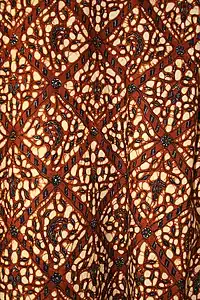Serge (fabric)
Serge is a type of twill fabric that has diagonal lines or ridges on both sides,[1] made with a two-up, two-down weave. The worsted variety is used in making military uniforms, suits, great coats and trench coats. Its counterpart, silk serge, is used for linings. French serge is a softer, finer variety. The word is also used for a high-quality woven woolen fabric.[2]

Etymology and history
The name is derived from Old French serge, itself from Latin serica, from Greek σηρικός (serikos), meaning "silken".[3] The early association of silk serge, Greece, and France is shown by the discovery in Charlemagne's tomb of a piece of silk serge dyed with Byzantine motifs, evidently a gift from the Byzantine Imperial Court in the 8th or 9th century AD. It also appears to refer to a form of silk twill produced in the early renaissance in or around Florence, used for clerical cassocks. A reference can be found in Don Quixote: "I am more pleased to have found it than anyone had given me a Cassock of the best Florentine serge" (The Curate, Book I, Chapter VI).
From early Saxon times, most English wool ("staples") was exported. In the early 16th century it went mainly to a Royal monopoly at Calais (then an English possession) and was woven into cloth in France or the Low Countries. However, with the liberation of Calais by the French on 7 January 1558, England began expanding its own weaving industry. This was greatly enhanced by the European Wars of Religion (Eighty Years' War, French Wars of Religion); in 1567 Calvinist refugees from the Low Countries included many skilled serge weavers,[4] while Huguenot refugees in the early 18th century included many silk and linen weavers.[5]
Wool worsted serges are known from the 12th century onward. Modern serges are made with worsted warp and a woollen weft.[6]
Denim is a cotton fabric with a similar weave; its name is believed to be derived from "serge de Nîmes" after Nîmes in France.[7]
References
- "serge", AccessScience, McGraw-Hill Global Education Holdings
- "
Fabric swatch NO. 1 SERGE" (Sep/Oct 2010) Selvedge No. 36, p.79, London ISSN 1742-254X
The article discusses the way in which the fabric serge has been used throughout history. - Online Etymology Dictionary
- Lambert, Tim. "A History of Southampton". www.localhistories.org. Retrieved 26 November 2017.
- "BBC - Legacies - Immigration and Emigration - England - London - The world in a city". www.bbc.co.uk. Retrieved 26 November 2017.
- MacLochlainn, Jason (2011). The Victorian Tailor: An Introduction to Period Tailoring. St. Martin's Griffin. p. 49. ISBN 9780312642334.
- Bryson, Bill (2016) [1994]. "'Manifest Destiny': Taming the West". Made in America. Transworld Publishers. p. 182. ISBN 978-1-784-16186-6.


.svg.png.webp)